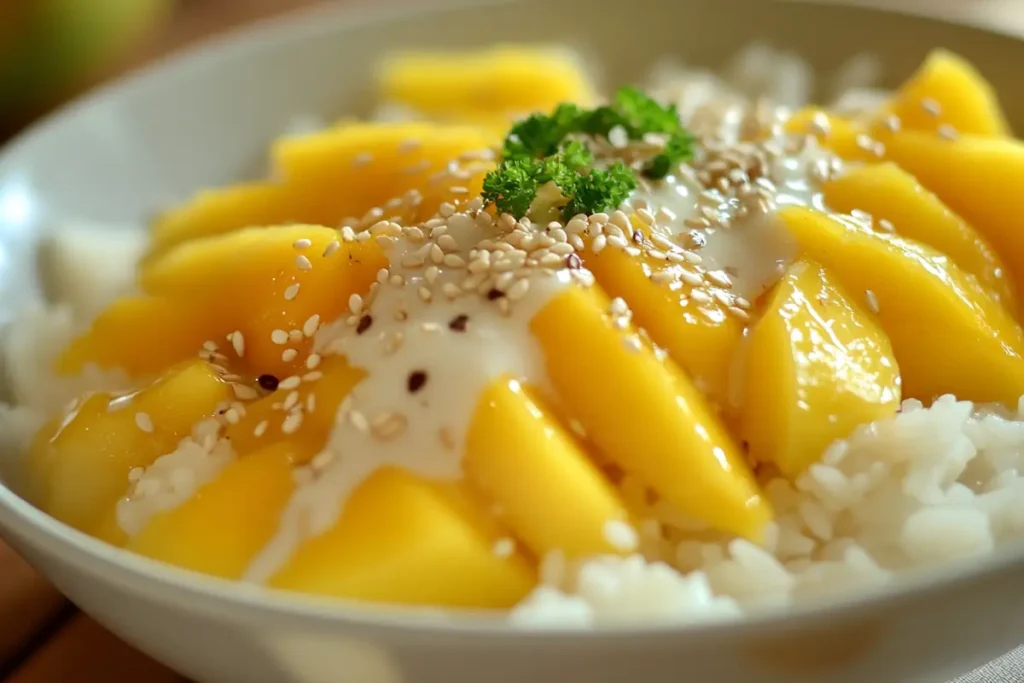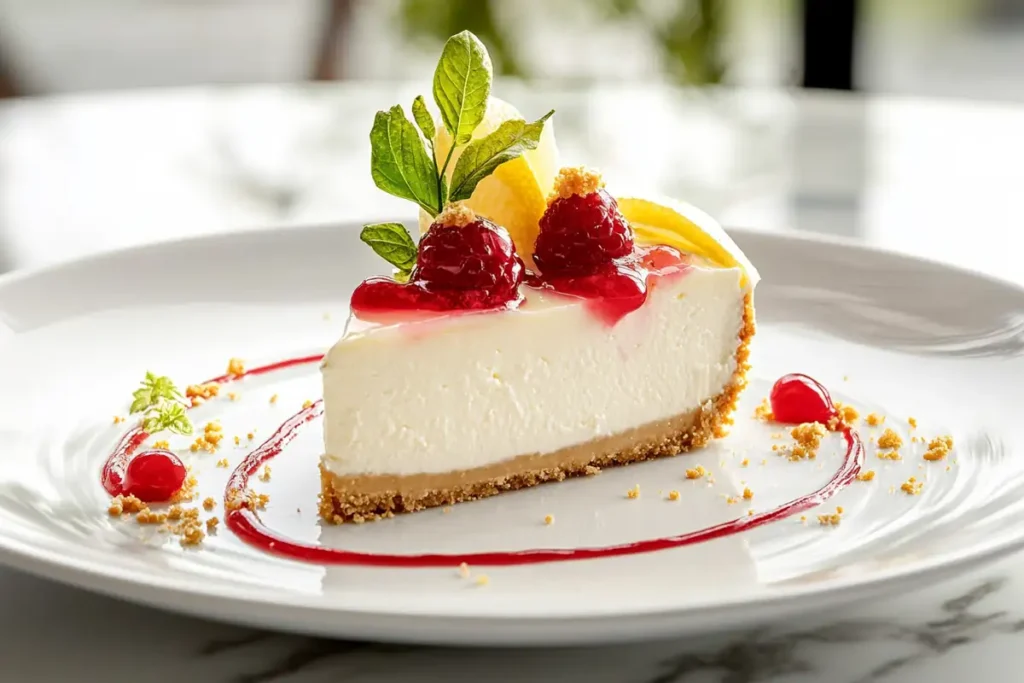Thai food is an unforgettable culinary experience, combining bold spices, tangy flavors, and aromatic herbs. But after indulging in such a delightful feast, many people wonder, what to serve for dessert after Thai food? The answer lies in striking the right balance between sweetness, texture, and refreshment. Whether you prefer an authentic Thai treat, a creative fusion dish, or a light Western dessert, this article has you covered. Let’s dive in!
The Characteristics of Thai Desserts
Understanding Thai Desserts
Thai desserts are a blend of history, tradition, and exquisite flavors. Unlike the heavy and overly sweet desserts found in some cuisines, Thai sweets are often light, fragrant, and made with ingredients that balance the richness of a meal.
The Flavor Profile of Thai Desserts
Thai desserts are renowned for their unique flavor profile, which harmonizes sweetness, saltiness, and a hint of floral aroma. They often incorporate tropical fruits, which add natural sweetness, and sometimes a mild tang. Subtle touches of pandan, a fragrant tropical plant, or the nuttiness of sesame seeds, elevate the flavors even further.
Key Ingredients in Thai Desserts
The magic of Thai desserts lies in their ingredients. Coconut milk, the backbone of many Thai recipes, imparts a creamy richness without being heavy. Palm sugar, a natural sweetener with caramel notes, is commonly used for its earthy undertones. Sticky rice, rice flour, and tapioca pearls provide texture, while tropical fruits like mango, durian, and jackfruit contribute natural sweetness and vibrancy.
These components work together to create desserts that aren’t just delicious but also refreshing—perfect for following a meal with bold flavors like Thai curry or pad thai.
Popular Thai Desserts for Authentic Pairings

Best Traditional Thai Desserts to Serve
When you’re considering what to serve for dessert after Thai food, traditional Thai sweets are an excellent choice. They’re designed to balance the bold, spicy flavors of the main meal while adding a touch of sweetness to the palate. Let’s explore some iconic Thai desserts that perfectly round off your meal.
Mango Sticky Rice (Khao Niew Mamuang)
This beloved classic combines glutinous rice cooked in sweetened coconut milk with slices of juicy, ripe mango. The dessert is typically garnished with a drizzle of coconut cream and a sprinkle of toasted sesame seeds for a delightful crunch. Its creamy texture and fruity freshness make it an ideal contrast to the spicy and tangy notes of Thai cuisine.
Thai Coconut Ice Cream (I-Tim Kati)
If you’re looking for something refreshing, Thai coconut ice cream is a fantastic option. Made with rich coconut milk and often served with roasted peanuts or jelly toppings, this dessert is cool, creamy, and not overly sweet. Its simplicity and cooling effect make it a favorite after a fiery green curry.
Thai Custard with Sticky Rice (Sang Kaya)
This decadent dessert features a silky custard made with coconut milk, palm sugar, and eggs, served alongside sticky rice. The custard’s deep caramel-like flavor pairs beautifully with the mildly sweet rice, creating a harmonious balance that’s incredibly satisfying.
Tub Tim Grob (Red Ruby Dessert)
For a dessert that’s as beautiful as it is delicious, tub tim grob is the way to go. This chilled sweet treat features crunchy water chestnuts coated in tapioca flour, dyed a bright ruby red, and served in sweetened coconut milk with crushed ice. It’s refreshing, light, and perfect for cleansing the palate after a hearty meal.
Khanom Chan (Layered Dessert)
Khanom chan, a steamed layered dessert made with pandan and coconut milk, is as visually appealing as it is delicious. Its chewy texture and mildly sweet flavor are a gentle way to end a meal, especially if you’re looking for something less rich.
Western Desserts That Pair Well with Thai Food

While traditional Thai desserts are a natural choice, sometimes you may want to mix things up with a Western twist. Many Western desserts complement the bold flavors of Thai cuisine by offering light, zesty, or creamy options that balance the meal beautifully.
Tropical Fruit Sorbets
Sorbets made with tropical fruits like mango, passion fruit, or pineapple are a refreshing and light option. Their natural acidity and icy texture provide a delightful contrast to the heat and complexity of Thai food. A mango sorbet, for instance, echoes the flavors of mango sticky rice while offering a more chilled and modern alternative.
Lemon or Lime Cheesecake
For a dessert that blends creamy richness with zesty brightness, lemon or lime cheesecake is an excellent choice. The tangy citrus flavor cuts through the heaviness of dishes like pad thai or massaman curry, leaving your palate refreshed. Opt for a cheesecake with a graham cracker crust for added texture.
Vanilla Panna Cotta with Mango Sauce
This creamy Italian dessert, when paired with a sweet mango puree, creates a fusion of smooth and fruity flavors. The panna cotta’s subtle vanilla taste is versatile enough to complement Thai spices without overpowering them. Drizzling mango sauce over the top ties the dessert back to the tropical elements of Thai cuisine.
Tips for Choosing the Perfect Dessert After Thai Food
Selecting the right dessert to follow a flavorful Thai meal is about more than just satisfying a sweet tooth. It’s about enhancing the dining experience by complementing the main course while providing balance and refreshment. Here are some expert tips to help you decide.
Considering the Main Course
When choosing what to serve for dessert after Thai food, consider the richness and spice level of the meal. If your main course was heavy, like massaman curry or fried rice dishes, a light and fruity dessert like sorbet or tub tim grob would be ideal. For lighter meals such as som tam (papaya salad) or tom yum soup, you can indulge in something creamier like mango sticky rice or cheesecake.
Balancing Sweetness and Spice
Thai food is known for its bold flavors, and desserts act as a palate cleanser. Look for desserts that are mildly sweet to balance the spice without overwhelming the taste buds. For example, the subtle sweetness of Thai custard pairs wonderfully with spicy stir-fries or noodle dishes.
Serving Temperature
Temperature plays a crucial role in dessert pairing. Cold desserts, such as Thai coconut ice cream or chilled panna cotta, are perfect for cooling down after a spicy meal. On the other hand, warm desserts like sticky rice with custard can be comforting, especially in cooler weather.
Drinks to Accompany Desserts After Thai Food

Desserts and drinks go hand-in-hand, and after enjoying a flavorful Thai meal, the right drink can elevate your dessert experience. Whether it’s a traditional Thai beverage or something simple and refreshing, the right choice will enhance the flavors of your dessert while providing balance.
Thai Iced Tea
Thai iced tea, with its creamy texture and sweet, aromatic flavor, is a natural pairing with Thai desserts. The tea’s slight bitterness, softened by condensed milk, complements the sweetness of desserts like mango sticky rice or Thai custard. Served over ice, it also helps cool the palate after spicy food.
Herbal Infusions
Herbal teas like lemongrass, pandan, or jasmine tea are light and fragrant, making them an excellent choice to accompany desserts. These teas enhance the tropical and floral notes in Thai sweets while aiding digestion. Plus, they’re caffeine-free, so they’re perfect for a relaxing end to the meal.
Sparkling Water with Lime
Sometimes, simplicity is key. Sparkling water with a hint of lime offers a refreshing way to cleanse the palate while enjoying rich or creamy desserts. The fizzy texture and citrusy tang balance the sweetness of dishes like coconut ice cream or panna cotta.
How to Serve Thai Desserts at Home
Serving Thai desserts at home is an art that combines presentation, authenticity, and practicality. Whether you’re hosting a dinner party or simply enjoying a cozy evening, these tips will help you serve Thai desserts that look and taste amazing.
Presentation Techniques
Thai desserts are as much about visual appeal as they are about flavor. Use vibrant tropical fruits, colorful garnishes, and traditional serving dishes to make your desserts stand out. For instance, serve mango sticky rice on a banana leaf or in a small bamboo basket for a touch of authenticity. Adding a sprinkle of toasted sesame seeds or edible flowers can also elevate the aesthetic.
Use of Authentic Ingredients
The key to capturing the essence of Thai desserts lies in using authentic ingredients like coconut milk, pandan, and palm sugar. Sourcing these ingredients from an Asian market or online specialty store ensures the flavors are true to the originals. Substitutions like regular sugar or canned fruits may compromise the taste and texture of the dessert.
Prepping Ahead
Many Thai desserts, such as tub tim grob or khanom chan, can be prepared in advance, making them ideal for gatherings. Prepping ahead not only saves time but also allows the flavors to develop further. For instance, the sticky rice in mango sticky rice becomes more flavorful when allowed to soak in coconut milk for a few hours.
FAQs: What to Serve for Dessert After Thai Food
What is a traditional Thai dessert?
Traditional Thai desserts include mango sticky rice, Thai custard with sticky rice, and tub tim grob. These sweets are light, fragrant, and balance sweet and savory flavors.
Can I serve Western desserts with Thai food?
Yes, Western desserts like lemon cheesecake, tropical fruit sorbets, and vanilla panna cotta with mango sauce pair well with Thai food, providing a fusion of flavors.
What fruit goes well with Thai food?
Tropical fruits such as mango, papaya, pineapple, and jackfruit are perfect complements to Thai cuisine due to their natural sweetness and vibrant flavors.
What drink pairs best with Thai desserts?
Thai iced tea, herbal teas like jasmine or lemongrass, and sparkling water with lime are excellent drink options to accompany Thai desserts.
How do you balance spicy and sweet in Thai cuisine?
Balancing spicy and sweet is key in Thai cooking. Desserts with mild sweetness, like coconut-based dishes or fruity sorbets, help cool the palate after spicy meals.
Can Thai desserts be made vegan?
Absolutely! Many Thai desserts are naturally vegan, as they use coconut milk instead of dairy. Ensure that other ingredients like pandan or tapioca are plant-based for a vegan-friendly treat.

